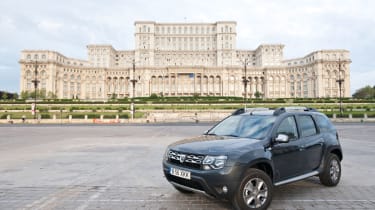

Out on the turbulent Lake Vastenjaure, the kayaks were set to cover more than 20 miles of 1.5-metre swell against constant headwinds. Temperatures stayed below the 5☌ mark with intermittent snowfall throughout the trip. The Duster’s proven off-road capabilities meant that the team were able to uncover and explore idyllic locations to pitch their tents.

The Duster was perfect for dropping off the kayaks in the water and picking them up at the other end. From Sulitelma, they headed to Ritsem in Sweden, travelling more than 130 miles by kayak and foot. The cold, humidity and ever-present mosquitoes were going to test them, but above all, the highest category IV and V rapids and waterfalls were the ultimate test.Įach carrying 20 kilos of equipment, including their kayaks, the crew ventured into the Lapland wilderness, driven by their thirst for freedom and testing their own limits. The crew of athletes prepared themselves to brave the biggest obstacles in unforgiving conditions. The expedition really came into its own.” The crew said: “The first rivers were amazing, but the more you ventured into the wilderness, the more grandiose it became. The road trip north was peppered with nights under the stars, riverside fishing stops, and test runs with the equipment. Having reached Stockholm, the team headed off to Sulitelma, Norway. Passing through Switzerland from France, and into Germany before taking a ferry to Sweden, the first leg of the expedition was a stretch of more than 1,800 miles. With the boot loaded and kayaks secured on the roof, the six athletes took to the road. The Duster’s generous boot volume, up to 1,574 litres, meant there was enough room for all the gear they needed. Rugged and robust, the Duster is built for adventure and met all the requirements of their expedition. The group met up in Grenoble in the southeast of France, where they set off in a Dacia Duster on their road-trip. The final crew member, Jonas Le Morvan, is well-known for winning the team race known as King of the Alps Extreme in 2017.

A heavyweight in today’s world of extreme kayaking, Thomas has taken to rivers around the world, from Pakistan to Canada and South America, in search of his next hit of adrenaline. "We had to have someone like him on the crew," his fellow kayakers added.įurther joining the team was Thomas Neime. The expedition also piqued the curiosity of Guillaume Hasson, a man with life-long experience with navigating rapids, as well in fixing cars and kayaks. In 2014, she became the first woman to descend the Grand Canyon of the Stikine, whose rapids are among the dangerous in the world. Joining the team was triple world champion, Nouria Newman. Along with Eric Deguil, he set up a crew of seasoned kayakers. With the help of maps and satellite imagery, Julien came up with the ‘dream expedition’ which he would talk about with athletes he met as he travelled the competition circuits. He is very familiar with the country’s wilderness having taught as a kayak instructor in Sweden for many years. The man behind organising the expedition, Julien Turin, is a remarkable kayaker who has spent the past 10 years planning a crossing of the Nordic regions. With kayaks secured on the roof and bivouac tents and equipment stored in the boot, the team were set for an adrenaline-packed expedition after more than a year of living in lockdown.Įric Deguil, four-time extreme kayak world champion and three-time winner of the Green Race – arguably one of the most gruelling races in the world – said: Venturing through unexplored lands and rivers in the stunning wilderness of Lapland, the fearless group used the Duster to haul their equipment north of the Arctic Circle, cut off from civilisation.īuilt for adventure, Dacia’s iconic SUV proved the ideal vehicle for the challenge as the team traversed nearly 5,000 miles to reach the wild waters in the North Cape region of Norway.


 0 kommentar(er)
0 kommentar(er)
